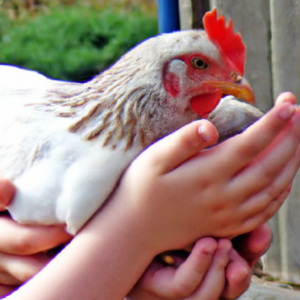
So you’ve got some feathery friends in your backyard and you’re looking for a way to keep them entertained and active? Well, look no further! In this article, we’re going to explore the exciting world of creating an obstacle course or agility training for chickens. Whether you’re a seasoned chicken enthusiast or just starting out, we’ve got you covered with tips, tricks, and ideas to make your chickens flap, jump, and cluck their way through a challenging and fun course. Get ready to witness your feathered companions showcase their hidden talents as we embark on this adventure together!

Choosing the Right Location and Equipment
Selecting a Suitable Space
When it comes to setting up an obstacle course or agility training for your chickens, it’s essential to choose a suitable space that provides enough room for the course. Look for an open area in your backyard or garden that is free from any potential hazards or predators. The space should be spacious enough for the chickens to move around comfortably without feeling cramped.
Gathering the Necessary Equipment
To create a chicken agility course, you’ll need various equipment to keep your feathered friends engaged and motivated. Some essential items include low hurdles, tunnels, ramps, perches, and platforms. These can be easily found at your local pet store or even made at home using simple materials like PVC pipes, wooden planks, and chicken wire. Additionally, you’ll also need treats and a clicker or a cue word for training purposes.
Designing and Setting up the Course
Determining the Course Layout
Before setting up the course, it’s important to plan and determine the layout of the obstacles. Take into consideration the available space and ensure that there is enough room between each obstacle for the chickens to navigate comfortably. Start by sketching out the course on paper, considering the flow and order of the obstacles to create a logical sequence for the chickens to follow.
Creating Different Obstacles
The key to keeping your chickens engaged and interested in the course is to create a variety of obstacles. Consider incorporating obstacles like low jumps, tunnels, balance beams, and ramps. These challenges can be made using simple materials like wooden boards, PVC pipes, and cardboard boxes. Be creative and vary the difficulty level, gradually increasing it as the chickens progress in their training.

Training the Chickens
Introducing the Chickens to the Course
Before jumping into training, it’s important to introduce your chickens to the course and allow them to explore it at their own pace. Place some treats or their regular feed near the obstacles to entice them to investigate. Allow them to familiarize themselves with the different obstacles and encourage them to interact with the course in a positive and stress-free manner.
Teaching Basic Commands
Once your chickens are comfortable with the course, it’s time to start teaching them basic commands. Begin by using treats to lure them over small obstacles or through tunnels. Use a clicker or a cue word such as “over” or “through” to associate their actions with the command. Train them consistently, rewarding them with treats and praise whenever they successfully complete an obstacle. Remember to be patient and give them time to understand and learn.
Progressing to Advanced Training
Increasing the Difficulty Level
As your chickens become more comfortable with the basic commands and obstacles, it’s time to increase the difficulty level of the course. Gradually raise the height of jumps, make tunnels narrower, or add more complex obstacles. By challenging their abilities, you’ll help them develop their agility and problem-solving skills.
Introducing Time Constraints
To further enhance their agility training, introduce time constraints for completing the course. Set a timer and encourage your chickens to complete the course within a certain timeframe. This will not only challenge them physically but also help them develop faster decision-making skills. Remember to reward them for their efforts and progress as they improve their speed and accuracy.

Ensuring Safety and Well-being
Maintaining a Clean and Secure Environment
While training your chickens, it’s important to ensure they are in a clean and secure environment. Regularly clean the course, removing any droppings or debris. Secure any loose equipment or obstacles to prevent accidents. Additionally, provide shade and fresh water for your chickens to keep them hydrated and comfortable during training sessions.
Monitoring the Chickens’ Physical Health
During training, it’s crucial to monitor your chickens’ physical health. Pay attention to their behavior, appetite, and overall well-being. If you notice any signs of illness or distress, consult a veterinarian immediately. Regular health check-ups and vaccinations are also essential to ensure your chickens are healthy and fit for training.
Adding Challenges and Variations
Incorporating Maze-like Structures
To make your course more interesting and challenging, consider incorporating maze-like structures. Using movable fencing or chicken wire, create pathways with twists and turns, encouraging your chickens to navigate through them. This will not only test their agility but also engage their problem-solving abilities as they figure out the correct path.
Including Feeding Stations
Another way to add variation to your chicken agility training is by incorporating feeding stations within the course. Place small bowls of their favorite treats at specific obstacles or after completing certain challenges. This will motivate your chickens to complete the obstacles and reinforce positive behavior. Remember to adjust the amount of feed based on your chickens’ individual dietary requirements.
Recording and Monitoring Progress
Keeping Track of Training Sessions
To measure the progress of your chickens’ agility training, it’s important to keep track of their training sessions. Create a training log or use a notebook to record the date, duration, and specific achievements during each session. This will help you identify areas that require improvement and track their overall growth and development.
Analyzing the Chickens’ Performance
Regularly analyze your chickens’ performance to assess their progress and identify any areas where they may need additional training. Observe their speed, accuracy, and problem-solving abilities during the course. This analysis will help you tailor their training program to meet their specific needs and ensure continual improvement.
Benefits of Chicken Agility Training
Enhancing Physical Fitness
Chicken agility training offers numerous benefits for your feathered friends. As they navigate through the obstacles, their muscles and joints are exercised, promoting overall physical fitness. Jumping, climbing, and running through the course helps improve their strength, coordination, and flexibility. Regular training can also contribute to weight management and reduce the risk of obesity.
Stimulating Mental Engagement
In addition to physical fitness, chicken agility training stimulates mental engagement and cognitive abilities. Navigating through obstacles requires problem-solving skills, concentration, and decision-making. It keeps their minds active and helps prevent boredom, leading to happier and healthier chickens. Mental stimulation can also decrease undesirable behaviors such as feather picking or aggression.
Sharing and Competing with Others
Joining Chicken Agility Competitions
Once you and your chickens have mastered their agility training, you can take it to the next level by joining chicken agility competitions. These events bring together chicken enthusiasts from all around, providing an opportunity to showcase your chickens’ skills and compete with other trained birds. Participating in competitions can be a fun and exciting way to bond with other chicken owners and learn from their experiences.
Participating in Online Communities
If competing in-person isn’t feasible, you can still share your chickens’ training progress and connect with fellow chicken enthusiasts through online communities. Numerous forums, social media groups, and websites dedicated to chicken agility training allow you to share videos, ask questions, and seek advice from experienced trainers. These communities offer a supportive and friendly environment where you can learn and grow as you continue your chicken agility journey.
Conclusion
Creating an obstacle course or agility training for your chickens is not only a fun and engaging activity but also offers a host of benefits for your feathered friends. By choosing the right location, gathering the necessary equipment, and employing effective training methods, you can enhance your chickens’ physical fitness and mental engagement. Remember to ensure their safety and well-being, add challenges and variations, monitor their progress, and consider participating in competitions or joining online communities. With determination, patience, and a friendly attitude, you can create a stimulating and rewarding agility training experience for your beloved chickens.







